[English] 日本語
 Yorodumi
Yorodumi- PDB-5otx: Extracellular domain of GLP-1 receptor in complex with GLP-1 vari... -
+ Open data
Open data
- Basic information
Basic information
| Entry | Database: PDB / ID: 5otx | ||||||
|---|---|---|---|---|---|---|---|
| Title | Extracellular domain of GLP-1 receptor in complex with GLP-1 variant Ala8Cys/Thr11Cys | ||||||
 Components Components |
| ||||||
 Keywords Keywords | SIGNALING PROTEIN / glucagon-like peptide 1 / GPCR / cyclic peptides | ||||||
| Function / homology |  Function and homology information Function and homology informationglucagon receptor binding / glucagon-like peptide 1 receptor activity / glucagon receptor activity / : / positive regulation of blood pressure / hormone secretion / post-translational protein targeting to membrane, translocation / negative regulation of execution phase of apoptosis / feeding behavior / response to psychosocial stress ...glucagon receptor binding / glucagon-like peptide 1 receptor activity / glucagon receptor activity / : / positive regulation of blood pressure / hormone secretion / post-translational protein targeting to membrane, translocation / negative regulation of execution phase of apoptosis / feeding behavior / response to psychosocial stress / positive regulation of calcium ion import / regulation of heart contraction / peptide hormone binding / Synthesis, secretion, and deacylation of Ghrelin / positive regulation of insulin secretion involved in cellular response to glucose stimulus / activation of adenylate cyclase activity / negative regulation of blood pressure / regulation of insulin secretion / positive regulation of gluconeogenesis / cellular response to glucagon stimulus / response to activity / gluconeogenesis / hormone activity / adenylate cyclase-modulating G protein-coupled receptor signaling pathway / adenylate cyclase-activating G protein-coupled receptor signaling pathway / Glucagon signaling in metabolic regulation / Synthesis, secretion, and inactivation of Glucagon-like Peptide-1 (GLP-1) / Glucagon-type ligand receptors / Glucagon-like Peptide-1 (GLP1) regulates insulin secretion / transmembrane signaling receptor activity / glucose homeostasis / positive regulation of cytosolic calcium ion concentration / secretory granule lumen / G alpha (s) signalling events / G alpha (q) signalling events / learning or memory / cell surface receptor signaling pathway / positive regulation of ERK1 and ERK2 cascade / receptor ligand activity / G protein-coupled receptor signaling pathway / endoplasmic reticulum lumen / signaling receptor binding / negative regulation of apoptotic process / extracellular space / extracellular region / identical protein binding / membrane / plasma membrane Similarity search - Function | ||||||
| Biological species |  Homo sapiens (human) Homo sapiens (human) | ||||||
| Method |  X-RAY DIFFRACTION / X-RAY DIFFRACTION /  MOLECULAR REPLACEMENT / Resolution: 2 Å MOLECULAR REPLACEMENT / Resolution: 2 Å | ||||||
 Authors Authors | Mortensen, S. | ||||||
 Citation Citation |  Journal: Biochemistry / Year: 2018 Journal: Biochemistry / Year: 2018Title: alpha-Helix or beta-Turn? An Investigation into N-Terminally Constrained Analogues of Glucagon-like Peptide 1 (GLP-1) and Exendin-4. Authors: Oddo, A. / Mortensen, S. / Thogersen, H. / De Maria, L. / Hennen, S. / McGuire, J.N. / Kofoed, J. / Linderoth, L. / Reedtz-Runge, S. | ||||||
| History |
|
- Structure visualization
Structure visualization
| Structure viewer | Molecule:  Molmil Molmil Jmol/JSmol Jmol/JSmol |
|---|
- Downloads & links
Downloads & links
- Download
Download
| PDBx/mmCIF format |  5otx.cif.gz 5otx.cif.gz | 68.6 KB | Display |  PDBx/mmCIF format PDBx/mmCIF format |
|---|---|---|---|---|
| PDB format |  pdb5otx.ent.gz pdb5otx.ent.gz | 50.1 KB | Display |  PDB format PDB format |
| PDBx/mmJSON format |  5otx.json.gz 5otx.json.gz | Tree view |  PDBx/mmJSON format PDBx/mmJSON format | |
| Others |  Other downloads Other downloads |
-Validation report
| Summary document |  5otx_validation.pdf.gz 5otx_validation.pdf.gz | 443.8 KB | Display |  wwPDB validaton report wwPDB validaton report |
|---|---|---|---|---|
| Full document |  5otx_full_validation.pdf.gz 5otx_full_validation.pdf.gz | 444.9 KB | Display | |
| Data in XML |  5otx_validation.xml.gz 5otx_validation.xml.gz | 12.8 KB | Display | |
| Data in CIF |  5otx_validation.cif.gz 5otx_validation.cif.gz | 17.7 KB | Display | |
| Arichive directory |  https://data.pdbj.org/pub/pdb/validation_reports/ot/5otx https://data.pdbj.org/pub/pdb/validation_reports/ot/5otx ftp://data.pdbj.org/pub/pdb/validation_reports/ot/5otx ftp://data.pdbj.org/pub/pdb/validation_reports/ot/5otx | HTTPS FTP |
-Related structure data
| Related structure data |  5ottC  5otuC  5otvC  5otwC  4zgmS S: Starting model for refinement C: citing same article ( |
|---|---|
| Similar structure data |
- Links
Links
- Assembly
Assembly
| Deposited unit | 
| ||||||||
|---|---|---|---|---|---|---|---|---|---|
| 1 | 
| ||||||||
| 2 | 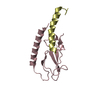
| ||||||||
| Unit cell |
|
- Components
Components
| #1: Protein | Mass: 13547.892 Da / Num. of mol.: 2 / Fragment: extracellular domain, UNP residues 24-139 Source method: isolated from a genetically manipulated source Source: (gene. exp.)  Homo sapiens (human) / Gene: GLP1R / Production host: Homo sapiens (human) / Gene: GLP1R / Production host:  #2: Protein/peptide | Mass: 3393.803 Da / Num. of mol.: 2 / Mutation: A8C, T11C / Source method: obtained synthetically / Source: (synth.)  Homo sapiens (human) / References: UniProt: P01275 Homo sapiens (human) / References: UniProt: P01275#3: Water | ChemComp-HOH / | Has protein modification | Y | |
|---|
-Experimental details
-Experiment
| Experiment | Method:  X-RAY DIFFRACTION / Number of used crystals: 1 X-RAY DIFFRACTION / Number of used crystals: 1 |
|---|
- Sample preparation
Sample preparation
| Crystal | Density Matthews: 1.99 Å3/Da / Density % sol: 38.27 % |
|---|---|
| Crystal grow | Temperature: 293 K / Method: vapor diffusion, sitting drop Details: Morpheus from Molecular Dimensions solution F2: 0.12 M Monosaccharides, 0.1 M Buffer system 1 pH 6.5, 20% (v/v) Ethylene Glycol, 10% (w/v) PEG8000 |
-Data collection
| Diffraction | Mean temperature: 100 K |
|---|---|
| Diffraction source | Source:  ROTATING ANODE / Type: RIGAKU FR-X / Wavelength: 1.54187 Å ROTATING ANODE / Type: RIGAKU FR-X / Wavelength: 1.54187 Å |
| Detector | Type: DECTRIS PILATUS3 R 1M / Detector: PIXEL / Date: Jan 18, 2017 |
| Radiation | Protocol: SINGLE WAVELENGTH / Monochromatic (M) / Laue (L): M / Scattering type: x-ray |
| Radiation wavelength | Wavelength: 1.54187 Å / Relative weight: 1 |
| Reflection | Resolution: 2→42.66 Å / Num. obs: 16996 / % possible obs: 94.4 % / Redundancy: 6.8 % / CC1/2: 0.998 / Rmerge(I) obs: 0.077 / Rpim(I) all: 0.032 / Rsym value: 0.083 / Net I/σ(I): 17.8 |
| Reflection shell | Resolution: 2→2.071 Å / Redundancy: 2 % / Rmerge(I) obs: 0.2312 / Mean I/σ(I) obs: 3.69 / Num. unique obs: 1622 / CC1/2: 0.895 / Rpim(I) all: 0.2228 / Rsym value: 0.3216 / % possible all: 92.26 |
- Processing
Processing
| Software |
| |||||||||||||||||||||||||||||||||||||||||||||||||||||||||||||||||||||||||||||||||||||||||||||||||||||||||
|---|---|---|---|---|---|---|---|---|---|---|---|---|---|---|---|---|---|---|---|---|---|---|---|---|---|---|---|---|---|---|---|---|---|---|---|---|---|---|---|---|---|---|---|---|---|---|---|---|---|---|---|---|---|---|---|---|---|---|---|---|---|---|---|---|---|---|---|---|---|---|---|---|---|---|---|---|---|---|---|---|---|---|---|---|---|---|---|---|---|---|---|---|---|---|---|---|---|---|---|---|---|---|---|---|---|---|
| Refinement | Method to determine structure:  MOLECULAR REPLACEMENT MOLECULAR REPLACEMENTStarting model: 4ZGM Resolution: 2→42.654 Å / SU ML: 0.24 / Cross valid method: FREE R-VALUE / Phase error: 24.54
| |||||||||||||||||||||||||||||||||||||||||||||||||||||||||||||||||||||||||||||||||||||||||||||||||||||||||
| Solvent computation | Shrinkage radii: 0.9 Å / VDW probe radii: 1.11 Å | |||||||||||||||||||||||||||||||||||||||||||||||||||||||||||||||||||||||||||||||||||||||||||||||||||||||||
| Refinement step | Cycle: LAST / Resolution: 2→42.654 Å
| |||||||||||||||||||||||||||||||||||||||||||||||||||||||||||||||||||||||||||||||||||||||||||||||||||||||||
| Refine LS restraints |
| |||||||||||||||||||||||||||||||||||||||||||||||||||||||||||||||||||||||||||||||||||||||||||||||||||||||||
| LS refinement shell |
|
 Movie
Movie Controller
Controller


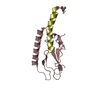
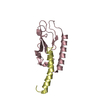
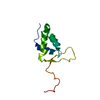

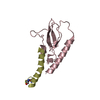
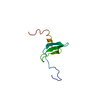

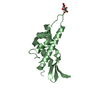
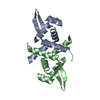

 PDBj
PDBj









